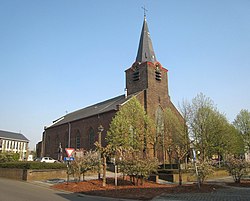Rotselaar
| Rotselaar | |||
|---|---|---|---|
| Municipality | |||

Church in Rotselaar
|
|||
|
|||
| Location in Belgium | |||
| Coordinates: 50°57′N 04°43′E / 50.950°N 4.717°ECoordinates: 50°57′N 04°43′E / 50.950°N 4.717°E | |||
| Country | Belgium | ||
| Community | Flemish Community | ||
| Region | Flemish Region | ||
| Province | Flemish Brabant | ||
| Arrondissement | Leuven | ||
| Government | |||
| • Mayor | Dirk Claes (CD&V) | ||
| • Governing party/ies | CD&V, N-VA | ||
| Area | |||
| • Total | 37.57 km2 (14.51 sq mi) | ||
| Population (1 January 2016) | |||
| • Total | 16,439 | ||
| • Density | 440/km2 (1,100/sq mi) | ||
| Postal codes | 3110, 3111, 3118 | ||
| Area codes | 016 | ||
| Website | rotselaar.be | ||
Rotselaar (Dutch pronunciation: [ˈrɔtsəlaːr]) is a municipality located in the Belgian province of Flemish-Brabant, near the convergence of the Demer and the Dijle. Since January 1, 1977 the municipality comprises the towns of Rotselaar proper, Werchter and Wezemaal. On January 1, 2006, Rotselaar had a total population of 15,068. The total area is 37.57 km² which gives a population density of 401 inhabitants per km².
Rotselaar is located at the convergence of two rivers, the Demer and the Dijle, which in turn have the Winge and the Losting as tributaries, and the Laak River forms the border between Werchter and Tremelo to the north. It's also located at the junction of three geographical areas. In rough terms, Werchter to the north of the Demer is a part of the South Campine, Wezemaal and Rotselaar Heikant of the Hageland, whereas Rotselaar-Centre to the west of the Dijle is a part of Binnen-Vlaanderen (Inner Flanders), which is also known as Dijleland.
Rotselaar and Wezemaal were first mentioned in written accounts in 1044. Only a century later, between 1138 and 1152, Werchter appears in historical documents.
In the 12th century, Rotselaar and Wezemaal were ruled by the Duke of Brabant, whereas the Counts of Aarschot and the House of the Berthouts controlled Werchter. From about 1170, vassals of the Duke of Brabant settled at Wezemaal and Rotselaar. In the course of the 13th century, these vassals rose to the nobility and started to "rule" the fiefdoms of Rotselaar and Wezemaal as lords. In the 14th century, the Lords of Wezemaal and Rotselaar managed to detract Werchter (and Haacht) from the sphere of influence of the House of the Berthouts, thus uniting the three villages of Wezemaal, Werchter and Rotselaar for the first time in history, which from that moment on together formed the Land, or the Barony of Rotselaar. The Barony of Rotselaar passed into the hands of the powerful House of Croÿ in 1516, to be added to the Margraviate of Aarschot, which was later elevated to the Duchy of Aarschot in 1533.
...
Wikipedia




